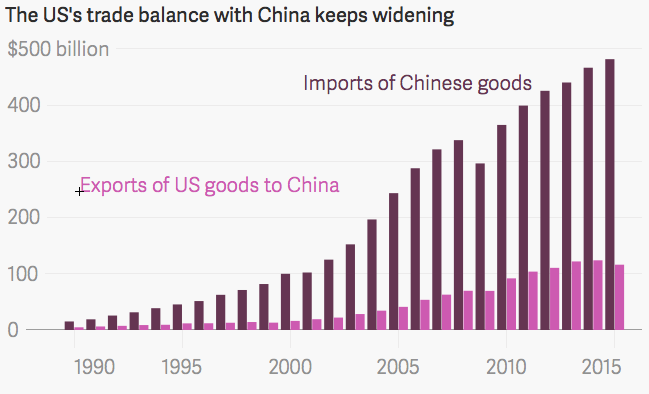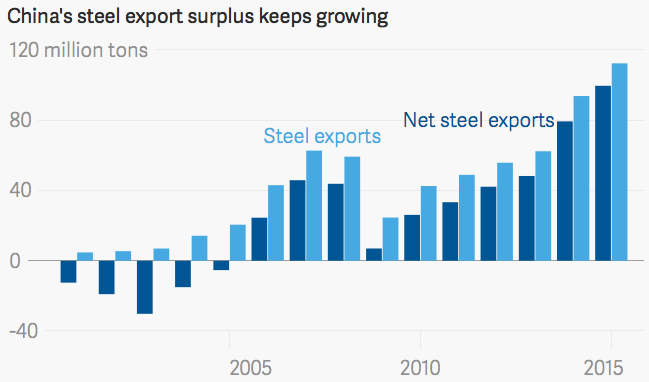
Donald Trump is on the lips of people around the globe. This is, arguably, one of the most discussed United States presidential contests in modern history. No matter where you are from or who you are, chances are you have heard that reality TV star Donald Trump is running for President of The United States of America. Whether he wins or not, what would a Trump presidency look like?
The Era of Donald Trump
While not everyone loves Trump, Quartz writer Gwynn Guilford believes that a Trump presidency would be “chaos”, pure and simple. Guilford backs up her opinion by writing a long answer to the question “what would a Trump presidency look like?”:
So now a new question: What would it really look like with Trump at America’s helm?

BYPASS THE CENSORS
Sign up to get unfiltered news delivered straight to your inbox.
You can unsubscribe any time. By subscribing you agree to our Terms of Use
In a word, chaos. In two, expensive chaos. That probably won’t surprise many Trump-haters out there. But here’s the surprise: While most of his proposals are sheer lunacy, some of his economic proposals are grounded in a surprisingly well-developed worldview—one that could arguably help American workers, though not without enormous disruption.
Deporting 11 million people isn’t easy
Maximum chaos first, though, which brings us to the Trump immigration plan. His most ambitious headline policy—deporting 11 million undocumented US residents within two years—faces some big practical, political, fiscal, and moral hurdles. It would be wildly expensive, for one.
“There’s no conceivable way in which it’s possible to immediately deport 11 million people,” said Edward Alden, a senior fellow at the Council on Foreign Relations who has previously advised Trump’s rival, Jeb Bush. “About the maximum you could deport is 400,000 a year. So you’re talking about a massive increase in budget and manpower to do this over some fairly quick period of time, like three years.”
Trump says he will triple the number of immigration and customs enforcement (ICE) employees by eliminating a tax credit that helps temporary resident families—most of which are poor and Latino—financially support their children. Republican lawmakers have failed time and again to turn that proposal into law.
Even finding those 11 million people is trickier than it might sound—at least if Trump wants to keep constitutional democracy intact, says Muzaffar Chishti, director of the Migration Policy Institute (MPI) at New York University. People who are deported are generally caught in one of two ways: immediately after crossing the border or after coming into contact with local law enforcement. But how would Trump find the rest?
“Even if you decide to send troops to neighborhoods, you’d never know where the undocumented are living. You would have to go to every single house and workplace and ask everyone for documentation,” says Chishti. “If you ask people [whether they’re undocumented] only based on perception, it’s a direct constitutional violation because you’re doing it on the basis of race.” Plus, each person still has the right to be heard in a US immigration court—and the current case backlog is already four to five years. (Trump dismisses this concern because they’re here illegally.)
Tearing apart families
Trump’s plan would also fray the social fabric of communities everywhere. Many of these 11 million are already married to legal residents; under US law, their status makes them ineligible for a spousal green card (this is one reason why the “path to citizenship” that’s so hotly debated among Republican candidates is so important).
Under current law, those deported can’t return for 10 years. This means deporting America’s undocumented population would therefore irrevocably break up families. Worse, some 5.1 million children live in households in which at least one parent is undocumented—and 4 million of those children are US-born, says Chishti. “So the decision these families would have to make is whether the children would live here without their parents,” he says. For his part, Trump says he wants to keep families together, “but they have to go.” He also plans to eliminate birthright citizenship. However, that wouldn’t change the existing legal status of those 4 million children. And while he plans to expedite the process of allowing deportees to return, he doesn’t say how.
A blow to the US economy
Then there’s the economic impact of mass deportations.
“Of the 11 million, we know for sure that between 7 million and 7.5 million are working. These are people working on various sides of our economy—from construction, to hospitality to elder care to childcare to restaurants—you name it. It’s across all of our occupations, especially in the low-wage sector,” says Chishti, adding that Trump must have many thousands working in his own hotels. “We don’t have a ready supply of US workers to take those jobs. So you would have a huge dent in the labor market.”
Trump says that the “really good and outstanding” workers can come back in through legal channels. But again, unless he changes the law, they’ll first have to wait 10 years before they can apply to legally reenter the US.
That will also hit US consumption. After all, America wouldn’t merely be shedding 3.5% of its consumers; millions of other families who remain will lose their breadwinners. Seventy percent of the US GDP comes from consumer spending.
A new chapter in religious discrimination
Another of Trump’s policies, the “total and complete shutdown of Muslims entering the US,” as his press release puts it, is similarly thorny. It’s unclear how the government would determine an applicant’s religion. “To the best of my knowledge, almost no passport says you’re Muslim,” says MPI’s Chishti. “So how would you do it? Are you going to ask people? Are you then going to make decisions based on self-definition or your definition?”
However Trump plans to achieve this, it would be unprecedented, says CFR’s Alden. Though the US has barred immigration on the basis of national origin—e.g. the Chinese Exclusion Act—it has never done so based strictly on religious grounds.
“That would be an outrageous violation of American history, tradition, and principles,” Alden says.
The great wall from China
Then we have Trump’s plan to build a wall that extends the 2,000 or so miles (3,220 kilometers) of border that the US shares with Mexico. Logistical and ecological problems abound. Perhaps the biggest challenge, though, is the cost of building it, which would range from $15 billion to $25 billion, according to MPI estimates, plus the cost of maintenance and patrols.
Trump says that Mexico will pay for the wall through a combination of customs duties, impounded remittances of illegal worker wages and higher fees on visas for Mexican CEOs, diplomats, NAFTA workers. Even assuming the legality of those measures, however, it’s not clear they will cover the expense.
This plan isn’t sitting too well with Mexican leaders. “We are not going to pay any single cent for such a stupid wall!” said former Mexican president Felipe Calderon earlier this week. “And it’s going to be completely useless.”
Ironically, this plan could benefit one of Trump’s other big bugbears, China—that’s where most of steel that makes up the existing US-Mexico border fence is produced, according to Alden. Though Trump would likely argue that the wall should be made with US steel, that would probably be tough to do; American steel manufacturers have long since shifted to high-end steel products. However, if the US buys Chinese steel, that could widen the US’s already gaping trade deficit with China.

“Winning” against Beijing
This brings us to perhaps the biggest pillar of Trump’s vision: taking jobs back from the People’s Republic. Many of his supporters, analysts say, are drawn from the white, middle-class Americans who have lost their low-skilled factory employment as those jobs have rapidly moved to low-cost labor markets like China’s over the last few decades.
Though his rhetoric might sound like a China-bashing ploy to rile up his base, Trump’s onto something. China’s currency manipulation and state subsidies have helped make its exports cheaper than those of its competitors, driving American manufacturers out of business or forcing them offshore. Steel, as it happens, is a good example of a sector that’s benefited from state largesse, allowing Chinese steelmakers to widen their share of the global market.

Of course, many other countries embrace similar trade policies. But thanks to its size, China hurts American workers the most. Between 2001 and 2013, the US’s goods trade deficit with China displaced some 3.2 million jobs, three quarters of which were in manufacturing—according to recent research by the left-leaning Economic Policy Institute (EPI).
It’s notable that instead of simply titling his position something general, like “fair trade,” he has labeled it“Reforming the US-China trade relationship to make America great again.”
But what would “winning” against China actually mean?
Trump laid out his boldest proposal—a 45% tariff on Chinese imports—in an interview with the New York Times that he later tried to deny.
Trump’s Chinese import tariff probably isn’t legal under World Trade Organization rules. However, he could still impose it for a while, says CFR’s Alden. “There are ways under trade rules where [a president] can declare an emergency of one sort or another… without the approval of Congress,” he says. “It would certainly be challenged in the WTO, but the WTO process is pretty slow.”
Aside from his tariff idea, Trump also wants to renegotiate the North American Free Trade Agreement and other trade pacts that disadvantage US workers, as well as penalize countries that deliberately weaken their own currencies.
Another Great Depression in the making?
Trump’s tariff might stop China from winning—but in the short term, it would throw the global economy and financial markets into a tailspin, says Robert Scott, economist at EPI.
For one thing, it could cause a big contraction in the US economy. The US no longer makes most of the stuff it buys from China, and Apple’s Steve Jobs famously concluded that those jobs are never coming back—not just because of cost, but because China now has the world’s most sophisticated manufacturing infrastructure.
Even assuming Trump finds some way to change that dynamic, it would take a long time to build those US factories and retrain workers. In the meantime, consumers would have to swallow much higher costs on the goods they buy from China, leaving them with less money to spend on everything else.
“For instance, we don’t make iPhones in the US,” says Scott. “The price of iPhones will increase from $600 to maybe $900 in a way that might suck more money out of the economy as it reduces spending power.”
It’s not just the US that would suffer. Because Americans buy goods from all over, the US is the main engine of global growth. A sudden spate of US penny-pinching could plunge the world economy into a downturn, or worse. And of course, the sudden shrinking of American demand would hurt China’s economy too, prompting mass layoffs as foreign companies pulled out and domestic firms shuttered factories—likely forcing that “hard landing” that its leaders have been so keen to avoid.
The end result could include a stock market crash as investors bail on Apple, Walmart, and other companies that sell China-made goods in the US. Stock prices of companies that depend on Chinese consumption would nosedive too.
China could retaliate with its own tariffs on US goods. However, if it did so, it would merely be shooting itself in the foot, says Scott. Most of what China imports from the US goes into making goods that it then ships back to America—things like scrap paper and steel, basic chemicals, raw plastic, and microchips. That means tariffs on US imports would up increasing the costs paid by its own manufacturers.
What Trump gets (sort of) right
This all sounds pretty chaotic. However, after the tumult subsided, Trump’s Chinese import tariff would benefit the US economy, says EPI’s Scott, emphasizing that he’s not endorsing Trump, just giving a dispassionate economic analysis of his policies.
“In the long run, if we could substantially reduce the trade deficit with China we would create millions of jobs in the US, and that would be very good for our economy,” he says. “It would reduce the federal budget deficit and stimulate the economy at no cost to the federal government other than the minor cost of sending lawyers to the WTO.”
Many economists and lawmakers blanch at this pro-tariff approach, labeling it either protectionism or dangerous geopolitical brinkmanship. But this free-market consensus among the US political establishment is precisely what Trump and his Democratic counterpart Bernie Sanders have had so much success in opposing. Their worry is that pro-free trade policies championed by every president since Ronald Reagan have opened up American markets without extracting equal concessions from trade partners. That lets other countries subsidize their own exports, putting Americans out of jobs.
Though Trump’s philosophy usually sounds wantonly pro-America, it’s hard to argue with the fact that a more balanced US economy would help force other countries to boost their own consumption too. Over time, that would lessen the now rampant risk of world-rattling banking crises and sovereign debt defaults. This would also shift wealth to middle-class consumers everywhere, creating new locomotives of global growth.
The problem with Trump’s vision is, it’s not clear when the benefits would smooth out the chaos caused. “As Keynes said, ‘In the long run, we are all dead,’” says Scott. “So we have to hope that we would still be around to enjoy the benefits of what Trump is proposing to do.”\
So, what do you think about this analysis of Donald Trump should he become president?


